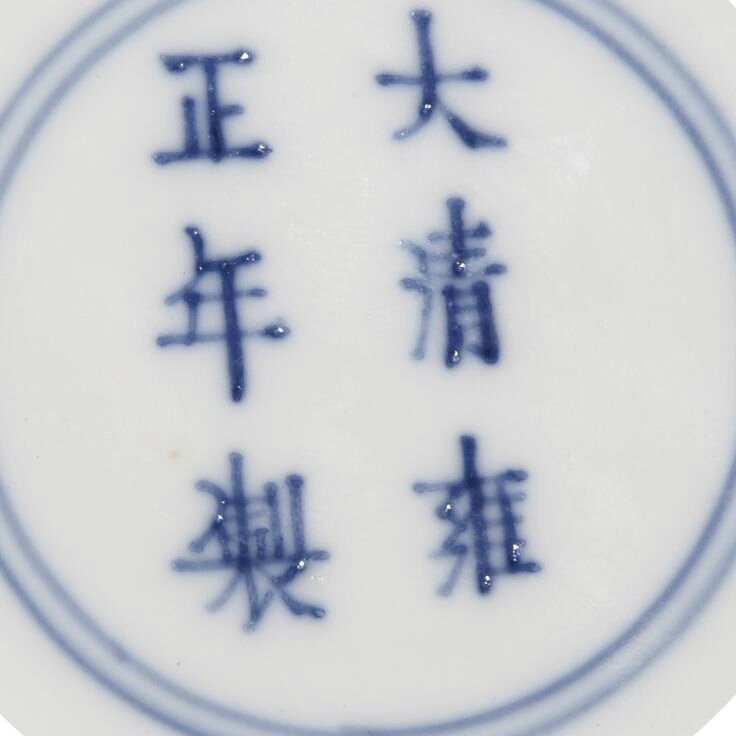A pair of famille-rose 'peony and magnolia' bowls, Yongzheng marks and period (1723-1735)
Lot 43. A pair of famille-rose 'peony and magnolia' bowls, Yongzheng marks and period (1723-1735). 17.9cm., 7in. Estimate 40,000 — 50,000 GBP. Lot sold 131,000 GBP. Photo Sotheby's.
each of ogee form, the deep sides with a constricted waist, rising from a gently splayed foot to a flared rim, brightly decorated to the exterior with three large peony blooms, two in iron-red and one in pink and white enamels, borne on meandering leafy branches rising from just above the foot, all entwined amongst flowering and budding branches of magnolia and crabapple, the interior left plain, inscribed to the base with a six-character reign mark within a double-circle, wood stands.
Provenance: Collection of Highfield Jones, prior to 1975.
Collection of Mrs C.C. Brinton.
Note: Innovative floral designs continued to flourish during the Yongzheng reign and these bowls exemplify this trend with their combination of flowers that extend across the exterior. Such developments are the product of the creative genius of Tang Ying (1682-1756), the superintendent at the Imperial kilns during the Yongzheng and early Qianlong reigns. Tang experimented with the use of arsenic lead-white enamel, which opened up the possibility of creating a new spectrum of pastel colours and hence innovative painting styles. The rendering of the peonies and magnolia on these bowls was inspired by the flower paintings of one of China’s most celebrated artist, Yun Shouping (1633-1690). Yun’s flowers, often painted in bold colours such as reds, purples and greens, were shaded through the use of lead-white in much the same way the new arsenic lead-white was used on porcelain.
A very similar pair of ogee bowls was sold at Christie’s New York, 20th November 1979, lot 272. See also a slightly smaller bowl of similar ogee form, in the Palace Museum, Beijing, illustrated in Qing Porcelain of Kangxi, Yongzheng and Qianlong from the Palace Museum Collection, Hong Kong, 1989, p. 1989, pl. 47; and another sold in our Hong Kong rooms, 17thNovember 1975, lot 119.
The design on these bowls is steeped in auspicious symbolism; as the combination of peonies (fuguihua), magnolia (yulan) and crab apple (haitang) forms the auspicious wish yutang fugui (‘May your house be blessed with wealth and honour’).
Sotheby's. Important Chinese Art, London, 11 november 2015, 11:00 AM

/https%3A%2F%2Fprofilepics.canalblog.com%2Fprofilepics%2F1%2F0%2F100183.jpg)
/https%3A%2F%2Fstorage.canalblog.com%2F03%2F02%2F119589%2F96711876_o.jpg)
/https%3A%2F%2Fstorage.canalblog.com%2F11%2F31%2F119589%2F94773502_o.jpg)
/https%3A%2F%2Fstorage.canalblog.com%2F20%2F83%2F119589%2F94772815_o.jpg)
/https%3A%2F%2Fstorage.canalblog.com%2F26%2F72%2F119589%2F75604929_o.jpg)
/https%3A%2F%2Fstorage.canalblog.com%2F59%2F60%2F119589%2F26458628_o.jpg)





/http%3A%2F%2Fstorage.canalblog.com%2F59%2F39%2F119589%2F129631842_o.jpg)
/http%3A%2F%2Fstorage.canalblog.com%2F77%2F79%2F119589%2F129631259_o.jpg)
/http%3A%2F%2Fstorage.canalblog.com%2F64%2F85%2F119589%2F129631160_o.jpg)
/http%3A%2F%2Fstorage.canalblog.com%2F09%2F41%2F119589%2F129627152_o.jpg)